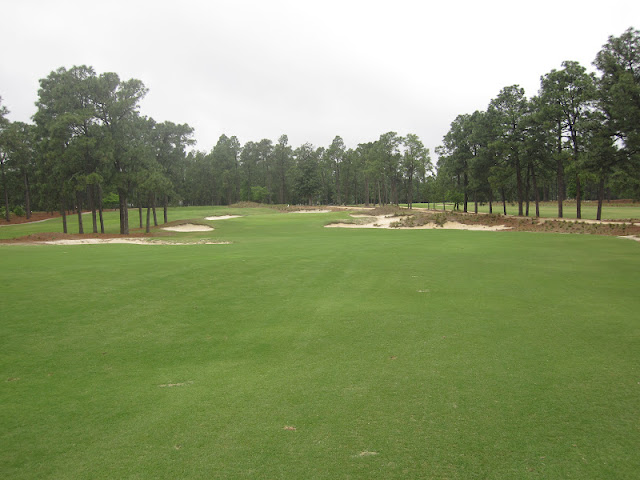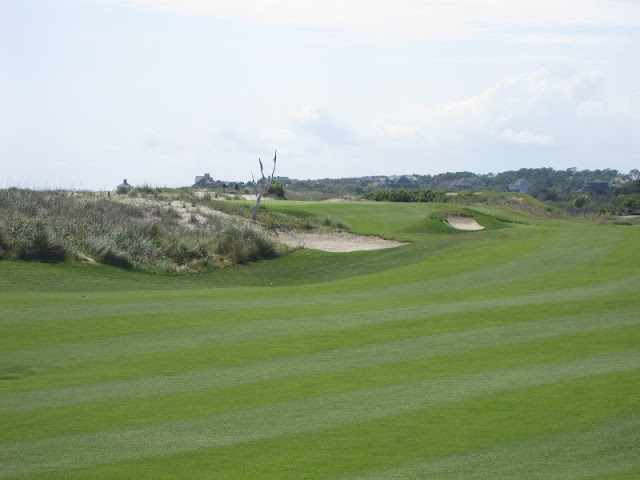As it’s name implies, Kinloch is a golf club. That is the only purpose they attempt to serve - and they do it extremely well. When the course was being developed, the decision was made to keep the area surrounding the course natural. The plans for housing development were scaled back accordingly. Emphasis was placed on making Kinloch a premier golf club. They exceeded in accomplishing their goal.
Access through the locked entrance gate was enabled through an intercom system. The staff were focused on providing everyone with an excellent golf experience. I was ready to enjoy!
Clubhouse and chipping area for warm-up
Round: #18
Location: Manakin-Sabot, Virginia
Golf Digest Best-In-State Rank: #1
Date: 24 Apr, tee off at 10:00 AM
Conditions: sunny skies, 12 MPH wind, 50 degrees
Yardage: 6,405
Lost balls: 1
Lost balls: 1
Score: 89 on a par 72
A par on the first hole gave me a good start on the round. With two more pars and four bogeys through the first 7-holes it looked like I might score fairly well in spite of the difficulty of the course. Than the wheels fell off with triple bogeys on holes 8 and 9. I like a course that penalizes the player for poor shots. Kinloch had started to dish out my punishment in large servings!
340-yard par 4 hole #2
523-yard par 5 hole #3 (view from the green back up the fairway)
310-yard par 4 hole #4
165-yard par 3 hole #5
407-yard par 4 hole #8 (the rough gave me plenty of trouble)
540-yard par 5 hole #9 (hit into the rough and lost a ball in the marshy area at the bottom of the fairway)
I was very pleased to join a threesome for the round. Ken Bartee is a member at Kinloch, even though he had to drive 2-hours from Fairfax to get to the club. Ken owned a software development business that he sold a few years ago. In addition to sitting on the James Madison University advisory board, he acts as a very gracious host on the golf course. The other two members of our group were Ken’s guests from Woodbridge, a 1-hour drive from the club. Keith Black managed a boat marina on the Potomac River. The marina stores has 400-boats that are pulled out and lower into the water when the owners are ready to go boating. Ken was formerly employed by Keith as a gas attendant on the docks (he did much better financially with software!). Ken’s second guest was Mike Hart. Mike also managed a boat marina on the Potomac river with 150 boats, ranging in size from 20’ to 45’ in length.
Caddy Caulin, Keith, Ken, Caddy Henry, & Mike
Our two young caddies were Henry and Caulin. Henry is married with 11-years of experience at Kinloch. He has worked as an assistant golf professional, in the food & beverage service and as a caddy. He best enjoys being a caddy and said the money is better than the assistant pro position. Caulin is 25-years old with a 9-year relationship with his girl friend. Both Henry and I gave him a hard time about his inability to step up and ask her to marry him. He said that day was coming; I was not quite sure.
When I was not teasing Caulin, I was trying to avoid any more triple bogeys on the back nine. There were plenty of opportunities to get into trouble, which I did on two holes when I double bogeyed. This was one of the first rounds of golf I have played with men who have shot a lower score than me. Keith & Mike were playing from the back tees, which means they added XXX yards in length to their game. They could hit much longer tee shots which enabled them to score well. Mike finished the round with a score of 76, after carding birdies on several holes. Keep in mind that he & Keith were playing from the gold tee boxes which added 400-yards in distance to their game over what I was playing. It was fun to watch him play.
405-yard par 4 hole #10
520-yard par 5 hole #13 (view of 2nd shot from the fairway)
130-yard par 3 hole #14
300-yard par 4 hole #15 (view of 2nd shot from the fairway - short par 4 but not an easy hole)
390-yard par 4 hole #16
377-yard par 4 Hole #18
As you could tell from the pictures above, no homes were built around the course. The only homes visible were were located across the small lake from the 18th green. Ken stated that each hole on the course looked different and provided varying challenges to the player. He was right!
We drove out of Virginia into Maryland where the Washington, D.C. traffic greeted our arrival. Our nephew Joseph Triplett works in Washington and was able to join us for dinner. His job entails overseas travel to places most Americans would never venture unless under military orders. Joseph described his most recent trip to Pakistan in a very calm, matter-of-fact manner over dinner. As much as Julie & I have traveled, I doubt if we will ever add Pakistan to our must-see destinations. Naturally our dinner conversation eventually turned to politics. Joseph is following the political developments with interest as you might expect from someone living in Washington. We both noticed how much he lit up when the conversation turned to the topic of sports. Joseph really likes his sports - and he follows a wide variety including the World Cup in soccer. I suspect he will be adding cricket to his interests if he keeps traveling to Pakistan. We left thinking he better pick out a woman to marry who shares his interest in sports, they would not need a remote control for their TV as the channel would never be changed from ESPN.

























































